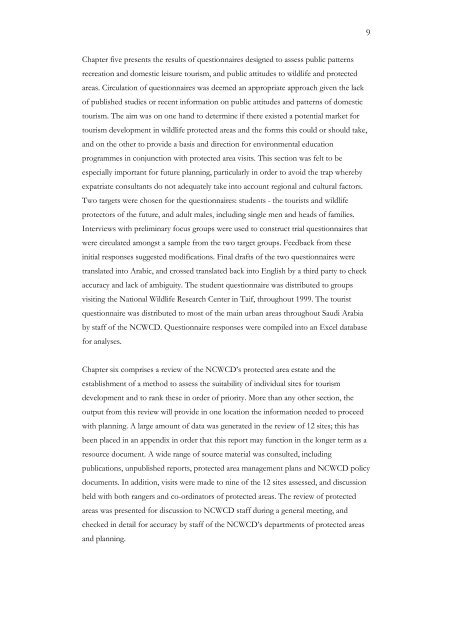The Unfenced Desert Towards a strategy for eco ... - Nwrc.gov.sa
The Unfenced Desert Towards a strategy for eco ... - Nwrc.gov.sa
The Unfenced Desert Towards a strategy for eco ... - Nwrc.gov.sa
Create successful ePaper yourself
Turn your PDF publications into a flip-book with our unique Google optimized e-Paper software.
Chapter five presents the results of questionnaires designed to assess public patterns<br />
recreation and domestic leisure tourism, and public attitudes to wildlife and protected<br />
areas. Circulation of questionnaires was deemed an appropriate approach given the lack<br />
of published studies or recent in<strong>for</strong>mation on public attitudes and patterns of domestic<br />
tourism. <strong>The</strong> aim was on one hand to determine if there existed a potential market <strong>for</strong><br />
tourism development in wildlife protected areas and the <strong>for</strong>ms this could or should take,<br />
and on the other to provide a basis and direction <strong>for</strong> environmental education<br />
programmes in conjunction with protected area visits. This section was felt to be<br />
especially important <strong>for</strong> future planning, particularly in order to avoid the trap whereby<br />
expatriate consultants do not adequately take into account regional and cultural factors.<br />
Two targets were chosen <strong>for</strong> the questionnaires: students - the tourists and wildlife<br />
protectors of the future, and adult males, including single men and heads of families.<br />
Interviews with preliminary focus groups were used to construct trial questionnaires that<br />
were circulated amongst a <strong>sa</strong>mple from the two target groups. Feedback from these<br />
initial responses suggested modifications. Final drafts of the two questionnaires were<br />
translated into Arabic, and crossed translated back into English by a third party to check<br />
accuracy and lack of ambiguity. <strong>The</strong> student questionnaire was distributed to groups<br />
visiting the National Wildlife Research Center in Taif, throughout 1999. <strong>The</strong> tourist<br />
questionnaire was distributed to most of the main urban areas throughout Saudi Arabia<br />
by staff of the NCWCD. Questionnaire responses were compiled into an Excel database<br />
<strong>for</strong> analyses.<br />
Chapter six comprises a review of the NCWCD’s protected area estate and the<br />
establishment of a method to assess the suitability of individual sites <strong>for</strong> tourism<br />
development and to rank these in order of priority. More than any other section, the<br />
output from this review will provide in one location the in<strong>for</strong>mation needed to proceed<br />
with planning. A large amount of data was generated in the review of 12 sites; this has<br />
been placed in an appendix in order that this report may function in the longer term as a<br />
resource document. A wide range of source material was consulted, including<br />
publications, unpublished reports, protected area management plans and NCWCD policy<br />
documents. In addition, visits were made to nine of the 12 sites assessed, and discussion<br />
held with both rangers and co-ordinators of protected areas. <strong>The</strong> review of protected<br />
areas was presented <strong>for</strong> discussion to NCWCD staff during a general meeting, and<br />
checked in detail <strong>for</strong> accuracy by staff of the NCWCD’s departments of protected areas<br />
and planning.<br />
9

















